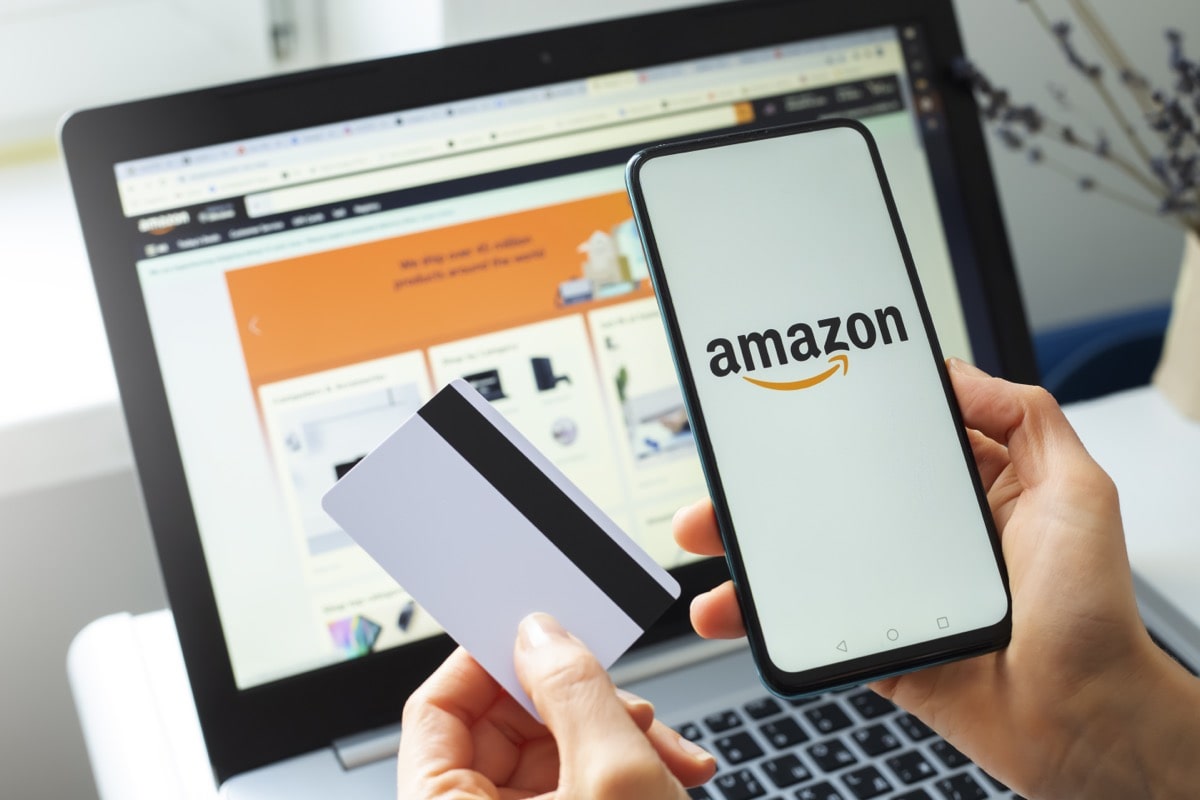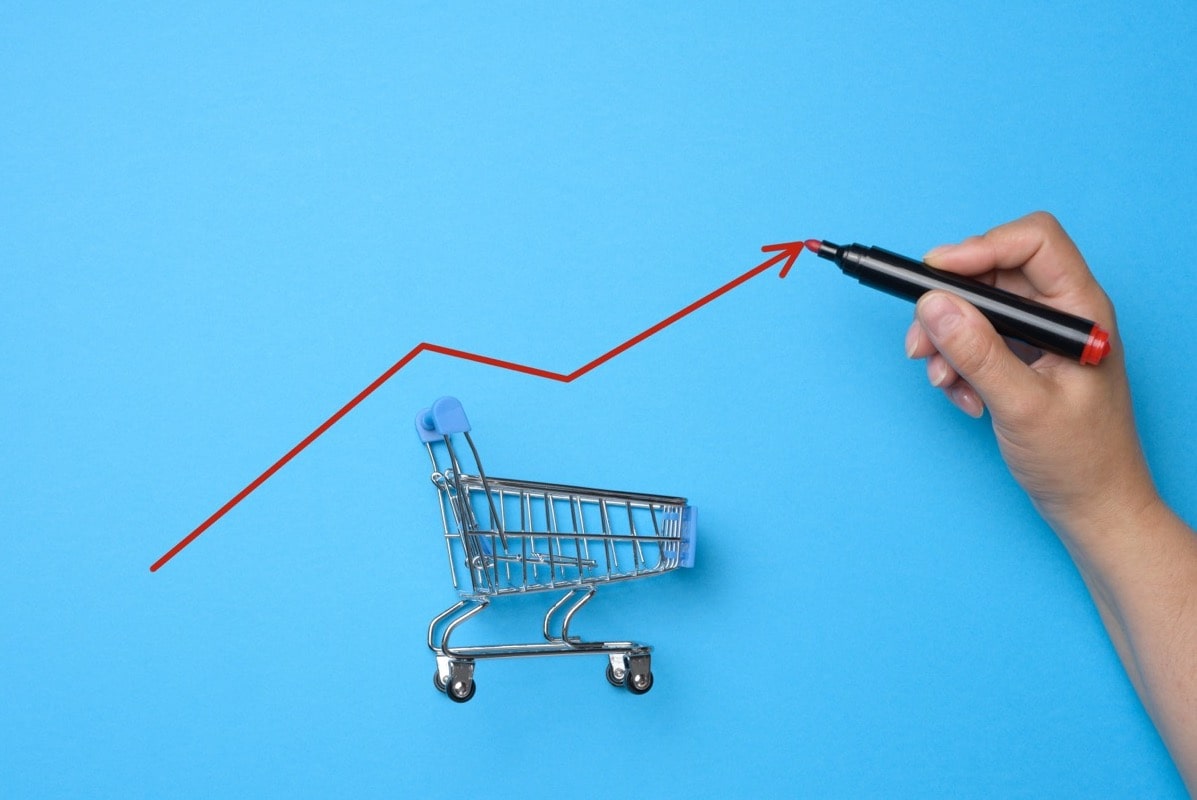Artificial intelligence (AI) is transforming numerous business routines. From data analytics to interaction with customers, global retail leaders apply AI solutions that improve their operational efficiency and user experience. Why shy away from the nascent technology? Take a look at creative AI applications in retail illustrated by the industry giant Amazon.

AI Adoption Rapidly Increases in Retail Industry
A 2021 KPMG study revealed that the use of artificial intelligence in retail first surged when the Covid-19 pandemic accelerated the disruption of the industry. At that point in time, 90% of retail business leaders indicated that their employees were ready and skilled enough to embrace AI adoption. Further 78% said their company had an AI code of ethics to mitigate the technology-related risks (e.g. AI bias, cybersecurity breaches, use of sensitive data for analytics).
Retail business leaders in 2021 expected that in the next two years, AI would have the biggest impact on customer intelligence (53%), inventory management (50%) and chatbots for customer service (49%).
Half (53%) of respondents admitted the pandemic had increased their company’s pace of adoption, while almost as many retail executives (49%) believed AI adoption was moving too fast for the industry to cope.
The challenges retailers had to overcome on their way to embracing AI included rapidly transforming and upgrading legacy internal systems, complying with data security and privacy regulations, and finding budget and resources for AI implementation while not neglecting other strategic priorities.
Two years later, not all the issues have not yet been resolved. However, the adoption of artificial intelligence has significantly accelerated with the advent of generative AI tools such as OpenAI’s ChatGPT or Google’s Bard. Not only US tech giants, but also their Chinese competitors such as Ant Group, Tencent Holdings or Baidu are developing their own generative AI solutions to enhance their retail and fintech services. The increasing competition and growing demand for AI tools are leading to another surge in AI adoption.
Global AI Market Size in Retail Industry
Different analytics give various estimates of the AI market growth within the retail segment. However, all of them agree that the market size will surge rapidly over the next few years. Here are a few related forecasts:
- The global market for the use of Artificial Intelligence (AI) in retail was valued at about 4.84 billion U.S. dollars in 2021. By 2028, the market for AI in retail is estimated to reach 31.18 billion U.S. dollars (Statista).
- The AI in Retail Market size is expected to grow from USD 7.30 billion in 2023 to USD 29.45 billion by 2028, at a CAGR of 32.17% (Mordor Intelligence).
- The global artificial intelligence in retail market size was valued at $5.50 billion in 2022 & is projected to grow from $7.14 billion in 2023 to $55.53 billion by 2030 (Fortune Business Insights).
- AI in Retail Markets is projected to exhibit a CAGR of 22.54% between 2023 and 2032 with growing investment from market players (Extrapolate).
- AI in Retail Market size was valued at USD 6 billion in 2022. Growing at an over 30% CAGR from 2023 to 2032, it can potentially reach more than USD 100 billion by 2032 (Global Market Insights).
How AI May Help Retailers
The range of potential use cases for artificial intelligence in the retail industry is enormous. Retailers are bound to be creative to stay ahead of their competitors. The need to differentiate themselves from the crowd of similar e-commerce solutions has never been greater. Customers are already accustomed to a certain level of personalisation, flexibility and comfort. Their expectations are high, pressing retailers to innovate and optimise their performance.
AI Chatbots in Retail
Chatbot interactions in retail were earlier predicted to reach 22 billion by 2023, delivering high-quality user experiences in a low-resource way, boosting customer retention and satisfaction whilst also reducing operating costs.
The majority of global retailers employ automation in their basic communication with customers, enabling human assistants to concentrate on more complex requests, complaints and individual issues.
In April 2023, Chinese tech giant Alibaba was reported to soon be introducing an AI-enabled chatbot assistant speaking both English and Mandarin. DoorDash, Apple, Wendy’s, Snapchat, Uber, TikTok, Morgan Stanley, Mercari, Lazada, and many other retail, tech, and financial companies are utilising their own versions of AI chatbots either for internal or external communication.
Many retailers combine the use of AI for their chatbots with other technology applications. For instance, Swedish fintech Klarna has cooperated with OpenAI to use ChatGPT as a shopping assistant, also adding an AI-enabled personalised shopping feed to its retail marketplace.
AI Use for Marketing Purposes
Generative AI tools like ChatGPT can facilitate marketing, automating analysis and targeting end customers. This creative service can also generate numerous keywords and categorise them for an ad campaign. Therefore, retailers can use AI in search engine marketing (SEM) or search engine optimization (SEO).
At the same time, the tool can also be used to get theoretical knowledge about the target markets, marketing strategies, specific advertising tactics and approaches, etc. The ever-learning AI can assist retail marketing teams with brainstorming for new ideas when they lack creativity and more.
In-Store Automation and Assistance
Many in-store processes can be handed over to artificial intelligence. Most of the manual and paper-based inventory management work can be eliminated, digitised and automated. Many retailers already employ such practices. Potentially, item searches for store customers can also be facilitated with computer vision and speech recognition technologies. AI-enabled tools are currently implemented in select automated unmanned stores. Besides, computer vision can be helpful for heat mapping in the store. Retailers can utilise camera recording information analysed by AI to develop experiences that encourage product engagement.
Forecast and Analytics
Running a store is not easy. It involves a lot of predictions based on market trends. AI helps to turn purchase data into actionable insights. That enables store owners to better plan their inventory orders, customise promotions and find the best discount timing. Predictive analysis is widely used in e-commerce, as a powerful machine learning AI tool.
“We see AI providing a sustainable solution for demand planning and forecasting, and data is at the heart of it. Having the ability to rapidly access and analyse data across your value chain will separate those who thrive from those who just survive.”
Duleep Rodrigo, national consumer & retail consulting leader at KPMG.
Personalization
Targeted ad campaigns and personalised promotions have better chances to reach their sales goals. Machine learning allows companies to divide customers into groups according to their interests and preferences. The benefit of AI is its ability to handle large amounts of data. That enables companies to transit from more general targeting (e.g. products for teens or stay-at-home moms) to highly precise personalisation. Relevant ads boost sales and increase customer engagement.
Cybersecurity
AI is also useful for fraud detection. Recently, the United States Securities and Exchange Commission (SEC) Chair Gary Gensler admitted that the SEC was leveraging AI to monitor the financial sector for signs of fraud and manipulation. Numerous companies in the fintech sector like Jack Henry or Deutsche Bank are also employing AI for fraud prevention. It is estimated that AI-enabled financial fraud detection spending will exceed $10 billion by 2027.
Meanwhile, retailers have faced an abnormal fraud rise both during and after the pandemic, as e-commerce sales surged. Artificial intelligence can effectively detect suspicious activity on a customer’s behalf, especially when it deals with loyal clients whose purchase patterns it can analyse.

How Amazon Uses AI to Optimise Its Operations
Being a global leader in retail, Amazon could not stand apart from the compelling AI technology. The e-commerce giant has been developing its proprietary AI and ML technology for more than 25 years. It is currently experimenting with artificial intelligence in different segments of its retail operations.
Product descriptions
On Sept. 13, Amazon launched a new set of generative AI capabilities to simplify creating listings for Amazon sellers. The new tool helps merchants draft more thorough and captivating product descriptions, bullet points, titles, and other listing details.
With the help of large language models (LLMs), creating product descriptions becomes fast and effortless. All sellers need to do is provide a brief description of the product.
The dedicated LLM was specifically trained on large amounts of data. It can recognise, summarise, translate, predict, and generate text and other content for product listings on Amazon. If a seller wants, they can refine the result. Otherwise, they can just use the generated text for a new listing. Early feedback indicates that the majority of merchants prefer the second variant.
“With our new generative AI models, we can infer, improve, and enrich product knowledge at an unprecedented scale and with dramatic improvement in quality, performance, and efficiency. Our models learn to infer product information through the diverse sources of information, latent knowledge, and logical reasoning that they learn. For example, they can infer a table is round if specifications list a diameter or infer the collar style of a shirt from its image.”
Robert Tekiela, Vice President of Amazon Selection and Catalog Systems
Customer Review Highlights
In August, Amazon introduced AI-generated review analysis that highlights the most important and significant parts of customer feedback on products purchased on the e-commerce giant’s platform. The new feature helps buyers determine at a glance whether a product is right for them.
The typical process of browsing through other buyers’ reviews is lengthy. Now, the generalised reviews generated by machine intelligence immediately show customers the main information about the product and its individual characteristics based on user comments. Moreover, the AI-generated review highlights feature insights based on key product attributes mentioned. It allows customers to more easily discover reviews dedicated to that particular product characteristic.
Contactless Unmanned Checkout
Amazon’s Just Walk Out contactless technology lets consumers enter a store, grab what they want, and leave without stopping at the checkout. Amazon leverages computer vision, sensor fusion, and deep learning to create a seamless unassisted shopping experience.
The AI-enabled technology is employed at its proprietary Amazon Go manless stores, on various college campuses in partnership with Grubhub and Transact Campus, in airports, sports stadiums, and entertainment venues like Six Flags theme park.
This September, Amazon updated its Just Walk Out solution to better suit the needs of fashion retailers. Although the cashierless tech was good at distinguishing products at grocery stores, it had difficulties with products that have similarities in appearance and weight such as apparel items. A new version of the technology uses radio frequency identification tags (RFID) in order to track clothing.
Palm Scan Payments
Back in 2020, Amazon introduced its contactless biometric payment solution Amazon One that allows customers to use their palm to pay or present a loyalty card at the store or other location.
Amazon One combines cutting-edge biometrics, optical engineering, generative AI, and machine learning. Namely, the e-commerce giant used generative AI to create a so-called “palm factory” producing millions of synthetic images of palms. This technology was used to train the dedicated AI model. Thus, instead of collecting millions of real people’s biometric data, Amazon leveraged AI-generated synthetic data that replicated the breadth and variety of real data as closely as possible.
AI quickly generated hand images reflecting a myriad of subtle changes, e.g. varying illumination settings, hand poses, and the presence of a Band-Aid or a ring. The images were also automatically “annotated,” so manual labelling was not required.
This fast, convenient, and contactless checkout experience has been rolled out in Amazon Go locations, Whole Foods stores, Panera Bread, Starbucks, travel retail points, and select entertainment venues. Throughout the years, Amazon also expanded the applications of Amazon One beyond payment to loyalty linking and age verification.
Flagging Defective Products
Amazon’s fulfilment centres are working on AI capabilities that can spot irregularities in the product line and flag defective products before they ship. Currently, this time-consuming process requires the work of up to five different employees that perform a six-point visual check. The innovative solution is being tested at one of Amazon’s facilities.
So far, the scarcity of damaged item data and the immense diversity of Amazon’s inventory have made AI-driven damage detection challenging. However, last year, the Amazon research team figured out they could supply a machine-learning model with “ideal” reference images. This way, AI would be able to compare the actual product it’s “looking at” with a model image of what the item should look like and find the differences.
The developed solution uses computer vision to scan items that pass through the Amazon warehouse. Next, a machine learning model analyses the received scans. It can discover hidden patterns to continuously improve the system’s ability to detect damage.
“We want to deploy our damage-detection software at a dozen operations in North America and Europe before the holiday season. Once in place, the technology will help scan for damage on over 40 million customer products every month, and it will be part of how we make sure people get undamaged gifts this holiday season.”
Christoph Schwerdtfeger, applied science manager at Amazon Fulfillment Technologies










